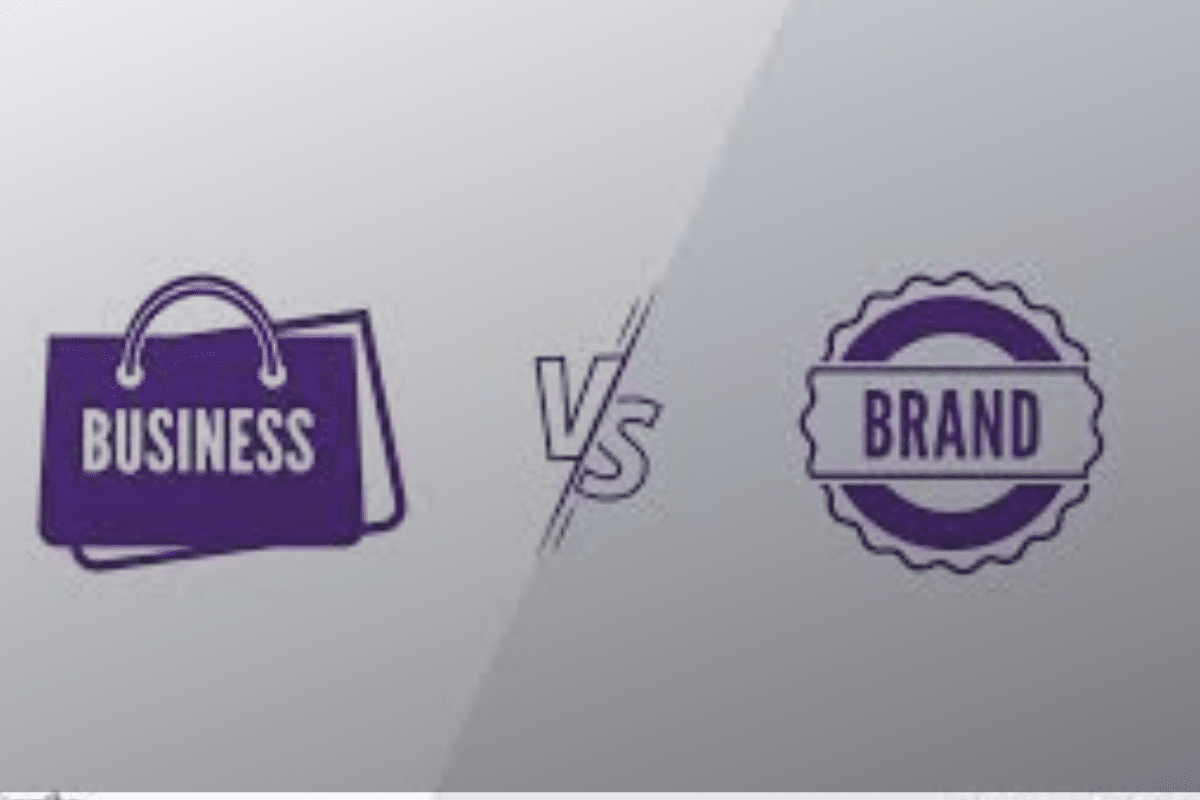Branding is the heart and soul of any successful company, in today’s attention deficient business world. Why attention deficient? Because, we have successfully surpassed a goldfish for having short attention spans.
The average human attention span as of 2024 is 8.25 seconds, and that of a goldfish is 9 seconds. This is why building a business is no longer enough: you must strive to build a brand.
Isn’t a brand and a business the same? If that’s what you’re wondering, the answer is no. No, they are not the same thing. Here’s what makes them different.
Difference Between A Brand and A Business
- A business is an operational entity providing goods and services to consumers. It is mainly focused on the transactional aspect of commerce. For example, selling products or services in exchange for money.
- A brand is an intangible concept that embodies the values and experiences of consumers associated with a business. It is the representation of the personality, voice, and values a business presents to its customers. A brand’s main concern is creating emotional connection and trust among current and prospective customers.
Fostering a brand is crucial for businesses to distinguish themselves in the overcrowded market. An effective branding strategy is critical for you to build a brand. Let’s look at how you can do that.
First, you need to understand what branding is.
What is Branding?
Branding is the process of utilizing marketing to create a unique and unified identity for your business across a multitude of platforms. It helps promote trust and loyalty among your audience.
Here’s why building trust and loyalty among your audience is important.
- 81% of consumers believe trust in a brand is crucial when making a purchase.
- 59% of consumers buy new products from businesses they are familiar with.
- Almost 77% of consumers make purchase decisions based on the brand name rather than the product name.
- Businesses that successfully establish an emotional connection with a brand can see upwards of 300% increase in lifetime revenue.
- Maintaining a consistent identity across platforms can increase revenue by up to 23%.
- 46% of consumers are willing to pay more to businesses they trust.
- 83% of consumers recommend a business they trust.
You might’ve noticed that all these stats include elements of trust and loyalty among consumers. If you want to foster these elements in your consumers, then you need an effective brand strategy.
How To Build An Effective Brand Strategy?
Brand strategies are the same for all brands. They include elements that are universal for the success of any brand, regardless of the industry. You can have a brand that sells sporting goods or a brand that is known for its apparel. The brand strategy will remain the same, the only thing that’ll change is your brand’s message, which will be tailored to your audience’s preferences.
An effective brand strategy includes the following universal elements.
1- Define Your Brand’s Purpose
What is the purpose of your brand’s existence? Answering this question will help you define your brand’s purpose.
When defining your brand’s purpose you must always align it with your target audience’s needs. A brand’s purpose includes;
- What are your brand’s core values?
- Who does your brand cater to?
- What problem does your brand aim to solve?
2- Clear Brand Values
Your brand’s values must always feel like a reflection of your target audience’s values. Consider what’s important to them and how they can guide your brand’s behavior.
Create a brand positioning statement that clearly conveys your brand’s values. This will also serve as a reminder for you and your customers of your brand’s values. Always make sure to communicate these values in your messaging. Not only that, you must also proactively work to uphold these values.
3- Brand Voice and Tone
Having a distinct brand tone and voice is a crucial element of an effective brand strategy. It helps give your brand a unique identity and personality. Your brand’s voice and tone must always be constant across every platform.
Having constant brand voice and tone also facilitates marketing efforts. A brand’s voice and tone is its unique way of communicating with its target audience. The content you produce must always reflect your brand’s voice.
4- Brand Design & Visual Identity
Much like consistent tone and voice, having a consistent design across brand visuals is also necessary. Your brand’s visuals are what your target audience will interact with the most.
Always make sure to use brand colors, typography, and multiple other visual elements that your audience can easily identify. One way to do this is by aligning them with your brand’s purpose and values. Distinct brand visuals lead to enhanced brand recognition and visibility.
Here’s an example that will prove why visual identity is crucial. Are you ready? Perfect! Close your eyes and think of a beverage that uses red labels for its branding. Most of you will instantly think of Coke. That’s how effective visual identity can be for a brand, when done right, of course.
5- Brand Story
Always use storytelling to foster emotional connections with your audience. Using storytelling, you can create a narrative around your brand, and as humans, we are wired to engage with narratives.
You must always have a brand story. A few things to consider when establishing a brand story are;
- It must be genuine.
- It must always cater to your audience’s preferences.
- The narrative created must convey your brand’s history, mission, and values.
Now that you know how to create an effective branding strategy. Here’s what you need to build a strong brand.

Key Strategies for Building A Strong Brand
Building a strong brand is essential to stand out in a competitive marketplace. Here are a few effective strategies that help establish a strong brand.
1- Understand Your Audience
This is the most crucial aspect of building a strong brand. If you don’t know what your target audience is interested in and what their preferences are, you’ll never be able to captivate them for business growth.
You must conduct thorough research to determine your target audience’s needs, preferences, and behaviors. Doing this will give you valuable insights into what type of content they engage with the most. What topics they strongly follow and what is their stance on certain social issues.
Understanding your target audience will also facilitate your branding efforts. Efforts such as creating a compelling brand story and developing consistent brand messaging.
2- Content Marketing
You must always remember that content is king of the digital world. When building a strong brand, it is essential to utilize content marketing effectively. You must always strive to engage your audience through content that educates and informs. Focusing solely on creating content for sales will not bear fruit.
The content you create must also be versatile. You can bring versatility in your content by including blogs, videos, infographics, and podcasts in your content marketing strategy.
3- Optimize Your Content For SEO
Optimizing your content and other digital assets like websites for search engines is important. It helps increase your brand’s online presence. You can do that by effectively utilizing SEO strategies. Strategies such as;
- Using Relevant Keywords.
- Optimizing Page Loading Speeds.
- Creating High Quality Content.
- Using Metadata and Alt text for images.
4- Foster A Community Around Your Brand
It is important to make your target audience feel valued. It helps promote a sense of community among them and fosters positive relationships between you and your target audience. You can promote a sense of community around your brand by regularly engaging with them.
You can also encourage interaction with your audience through social media, other online forums, and events. Creating a community will attract more customers that share your brand’s values. Not only that, it is also crucial to promote loyalty and brand advocacy. As already mentioned in the sections above, loyalty and trust are paramount for a brand’s success.
5- Never Fear Innovation
When building a strong brand, it is important to understand that your audience’s needs and preferences are not static. They evolve over time, and so must you.
You must always be proactive and keep an eye out on changing market trends that can influence your audience. This will help you position your brand accordingly and keep your audience intact.
By remaining adaptable according to evolving trends, you maintain relevance and competitiveness in your industry.
Other strategies that can help build a strong brand include;
- Effective Communication: This includes timely responding to customer inquiries and suggestions. It also helps promote brand loyalty and trust.
- Managing Brand Reputation: It is important to regularly assess your brand’s reputation. You can do it through customer feedback and online reviews. If you come across any negative perceptions, you must promptly address them. This will help you manage a positive brand image.
Branding Can Be Tough
Managing a business is already tough. If you add the responsibility of effectively carrying out its branding, it can become overwhelming. It is especially true if you are not experienced in marketing. That’s why most businesses rely on expert marketers to carry out their branding needs. So, can you!
Contact us today and our expert marketers with proven track records will take care of all your branding needs.



